2005 CHEVROLET VENTURE garage door opener
[x] Cancel search: garage door openerPage 139 of 470
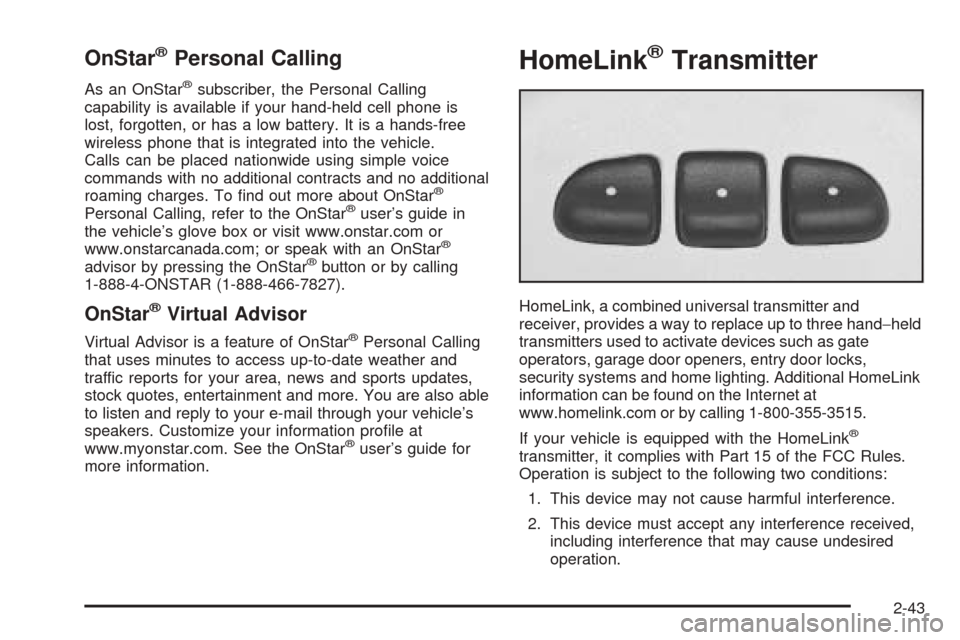
OnStar®Personal Calling
As an OnStar®subscriber, the Personal Calling
capability is available if your hand-held cell phone is
lost, forgotten, or has a low battery. It is a hands-free
wireless phone that is integrated into the vehicle.
Calls can be placed nationwide using simple voice
commands with no additional contracts and no additional
roaming charges. To �nd out more about OnStar
®
Personal Calling, refer to the OnStar®user’s guide in
the vehicle’s glove box or visit www.onstar.com or
www.onstarcanada.com; or speak with an OnStar
®
advisor by pressing the OnStar®button or by calling
1-888-4-ONSTAR (1-888-466-7827).
OnStar®Virtual Advisor
Virtual Advisor is a feature of OnStar®Personal Calling
that uses minutes to access up-to-date weather and
traffic reports for your area, news and sports updates,
stock quotes, entertainment and more. You are also able
to listen and reply to your e-mail through your vehicle’s
speakers. Customize your information pro�le at
www.myonstar.com. See the OnStar
®user’s guide for
more information.
HomeLink®Transmitter
HomeLink, a combined universal transmitter and
receiver, provides a way to replace up to three hand−held
transmitters used to activate devices such as gate
operators, garage door openers, entry door locks,
security systems and home lighting. Additional HomeLink
information can be found on the Internet at
www.homelink.com or by calling 1-800-355-3515.
If your vehicle is equipped with the HomeLink
®
transmitter, it complies with Part 15 of the FCC Rules.
Operation is subject to the following two conditions:
1. This device may not cause harmful interference.
2. This device must accept any interference received,
including interference that may cause undesired
operation.
2-43
Page 140 of 470
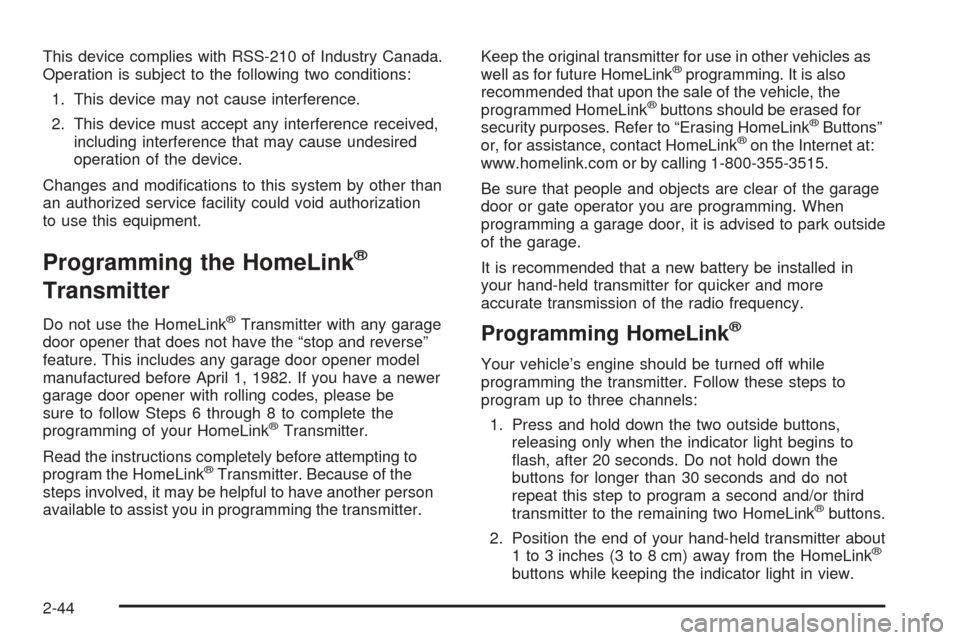
This device complies with RSS-210 of Industry Canada.
Operation is subject to the following two conditions:
1. This device may not cause interference.
2. This device must accept any interference received,
including interference that may cause undesired
operation of the device.
Changes and modi�cations to this system by other than
an authorized service facility could void authorization
to use this equipment.
Programming the HomeLink®
Transmitter
Do not use the HomeLink®Transmitter with any garage
door opener that does not have the “stop and reverse”
feature. This includes any garage door opener model
manufactured before April 1, 1982. If you have a newer
garage door opener with rolling codes, please be
sure to follow Steps 6 through 8 to complete the
programming of your HomeLink
®Transmitter.
Read the instructions completely before attempting to
program the HomeLink
®Transmitter. Because of the
steps involved, it may be helpful to have another person
available to assist you in programming the transmitter.Keep the original transmitter for use in other vehicles as
well as for future HomeLink
®programming. It is also
recommended that upon the sale of the vehicle, the
programmed HomeLink
®buttons should be erased for
security purposes. Refer to “Erasing HomeLink®Buttons”
or, for assistance, contact HomeLink®on the Internet at:
www.homelink.com or by calling 1-800-355-3515.
Be sure that people and objects are clear of the garage
door or gate operator you are programming. When
programming a garage door, it is advised to park outside
of the garage.
It is recommended that a new battery be installed in
your hand-held transmitter for quicker and more
accurate transmission of the radio frequency.
Programming HomeLink®
Your vehicle’s engine should be turned off while
programming the transmitter. Follow these steps to
program up to three channels:
1. Press and hold down the two outside buttons,
releasing only when the indicator light begins to
�ash, after 20 seconds. Do not hold down the
buttons for longer than 30 seconds and do not
repeat this step to program a second and/or third
transmitter to the remaining two HomeLink
®buttons.
2. Position the end of your hand-held transmitter about
1 to 3 inches (3 to 8 cm) away from the HomeLink
®
buttons while keeping the indicator light in view.
2-44
Page 141 of 470
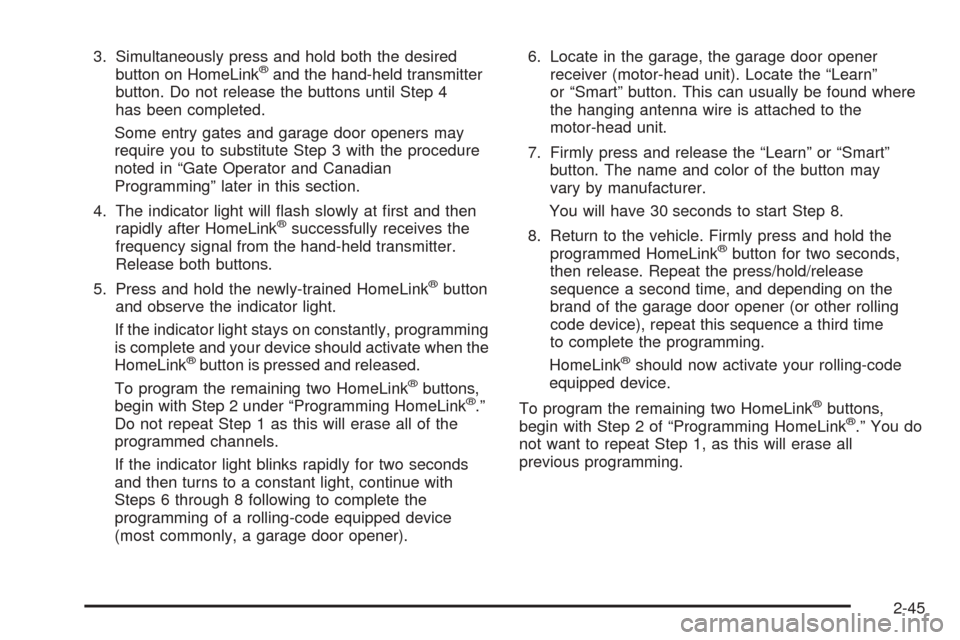
3. Simultaneously press and hold both the desired
button on HomeLink®and the hand-held transmitter
button. Do not release the buttons until Step 4
has been completed.
Some entry gates and garage door openers may
require you to substitute Step 3 with the procedure
noted in “Gate Operator and Canadian
Programming” later in this section.
4. The indicator light will �ash slowly at �rst and then
rapidly after HomeLink
®successfully receives the
frequency signal from the hand-held transmitter.
Release both buttons.
5. Press and hold the newly-trained HomeLink
®button
and observe the indicator light.
If the indicator light stays on constantly, programming
is complete and your device should activate when the
HomeLink
®button is pressed and released.
To program the remaining two HomeLink®buttons,
begin with Step 2 under “Programming HomeLink®.”
Do not repeat Step 1 as this will erase all of the
programmed channels.
If the indicator light blinks rapidly for two seconds
and then turns to a constant light, continue with
Steps 6 through 8 following to complete the
programming of a rolling-code equipped device
(most commonly, a garage door opener).6. Locate in the garage, the garage door opener
receiver (motor-head unit). Locate the “Learn”
or “Smart” button. This can usually be found where
the hanging antenna wire is attached to the
motor-head unit.
7. Firmly press and release the “Learn” or “Smart”
button. The name and color of the button may
vary by manufacturer.
You will have 30 seconds to start Step 8.
8. Return to the vehicle. Firmly press and hold the
programmed HomeLink
®button for two seconds,
then release. Repeat the press/hold/release
sequence a second time, and depending on the
brand of the garage door opener (or other rolling
code device), repeat this sequence a third time
to complete the programming.
HomeLink
®should now activate your rolling-code
equipped device.
To program the remaining two HomeLink
®buttons,
begin with Step 2 of “Programming HomeLink®.” You do
not want to repeat Step 1, as this will erase all
previous programming.
2-45
Page 144 of 470
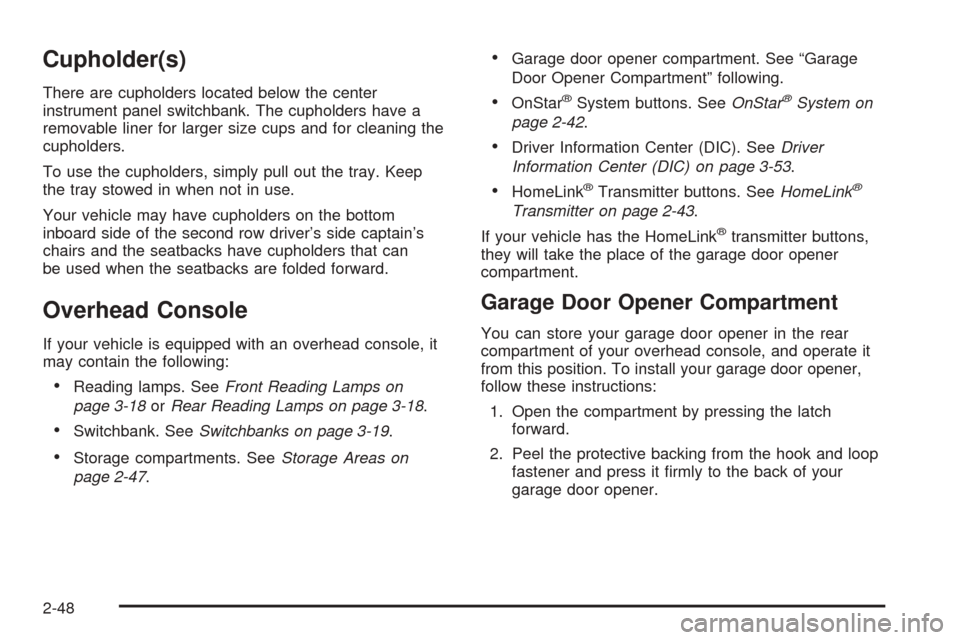
Cupholder(s)
There are cupholders located below the center
instrument panel switchbank. The cupholders have a
removable liner for larger size cups and for cleaning the
cupholders.
To use the cupholders, simply pull out the tray. Keep
the tray stowed in when not in use.
Your vehicle may have cupholders on the bottom
inboard side of the second row driver’s side captain’s
chairs and the seatbacks have cupholders that can
be used when the seatbacks are folded forward.
Overhead Console
If your vehicle is equipped with an overhead console, it
may contain the following:
Reading lamps. SeeFront Reading Lamps on
page 3-18orRear Reading Lamps on page 3-18.
Switchbank. SeeSwitchbanks on page 3-19.
Storage compartments. SeeStorage Areas on
page 2-47.
Garage door opener compartment. See “Garage
Door Opener Compartment” following.
OnStar®System buttons. SeeOnStar®System on
page 2-42.
Driver Information Center (DIC). SeeDriver
Information Center (DIC) on page 3-53.
HomeLink®Transmitter buttons. SeeHomeLink®
Transmitter on page 2-43.
If your vehicle has the HomeLink
®transmitter buttons,
they will take the place of the garage door opener
compartment.
Garage Door Opener Compartment
You can store your garage door opener in the rear
compartment of your overhead console, and operate it
from this position. To install your garage door opener,
follow these instructions:
1. Open the compartment by pressing the latch
forward.
2. Peel the protective backing from the hook and loop
fastener and press it �rmly to the back of your
garage door opener.
2-48
Page 145 of 470
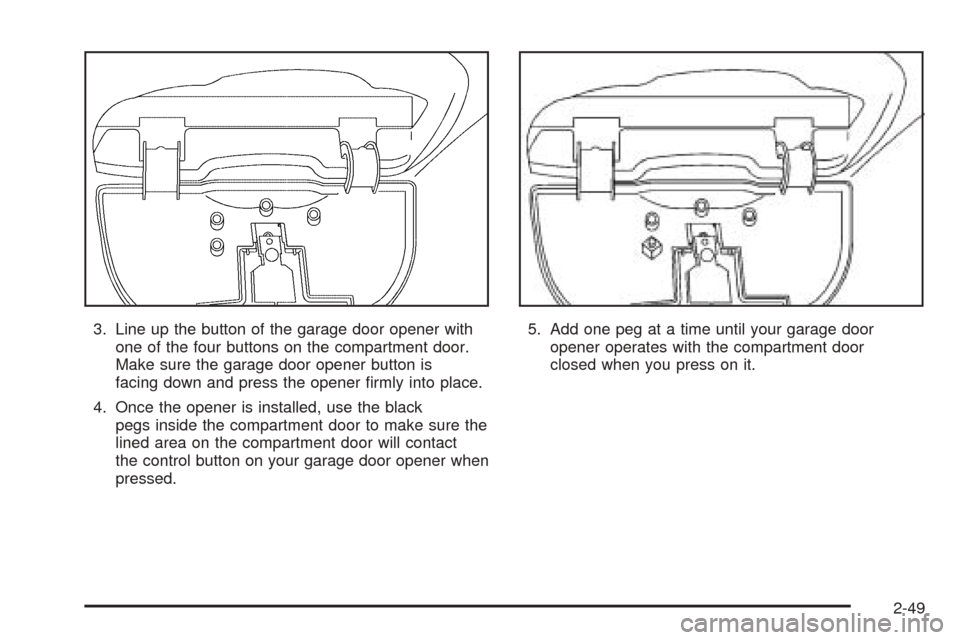
3. Line up the button of the garage door opener with
one of the four buttons on the compartment door.
Make sure the garage door opener button is
facing down and press the opener �rmly into place.
4. Once the opener is installed, use the black
pegs inside the compartment door to make sure the
lined area on the compartment door will contact
the control button on your garage door opener when
pressed.5. Add one peg at a time until your garage door
opener operates with the compartment door
closed when you press on it.
2-49
Page 462 of 470

Fuses
Fuses and Circuit Breakers...........................5-92
Instrument Panel Fuse Block.........................5-93
Underhood Fuse Block.................................5-96
Windshield Wiper.........................................5-92
G
Gage
Engine Coolant Temperature.........................3-41
Fuel..........................................................3-45
Speedometer..............................................3-35
Tachometer.................................................3-37
Garage Door Opener.......................................2-43
Gasoline
Octane........................................................ 5-5
Speci�cations............................................... 5-5
Glove Box.....................................................2-47
GM Mobility Reimbursement Program.................. 7-5
H
Hatch Ajar Warning Message............................3-51
Hazard Warning Flashers................................... 3-6
Head Restraints............................................... 1-6
Headlamp Wiring............................................5-92Headlamps....................................................5-46
Bulb Replacement.......................................5-45
Daytime Running Lamps/Automatic
Headlamp System....................................3-14
Flash-to-Pass............................................... 3-8
Front Turn Signal, Sidemarker and
Parking Lamps.........................................5-48
Halogen Bulbs............................................5-45
High/Low Beam Changer................................ 3-8
Heater...........................................................3-24
Highbeam On Light.........................................3-45
Highway Hypnosis...........................................4-22
Hill and Mountain Roads..................................4-22
HomeLink
®Transmitter....................................2-43
HomeLink®Transmitter, Programming................2-44
Hood
Checking Things Under................................5-10
Release.....................................................5-11
Horn............................................................... 3-6
How to Use This Manual...................................... ii
How to Wear Safety Belts Properly...................1-34
6